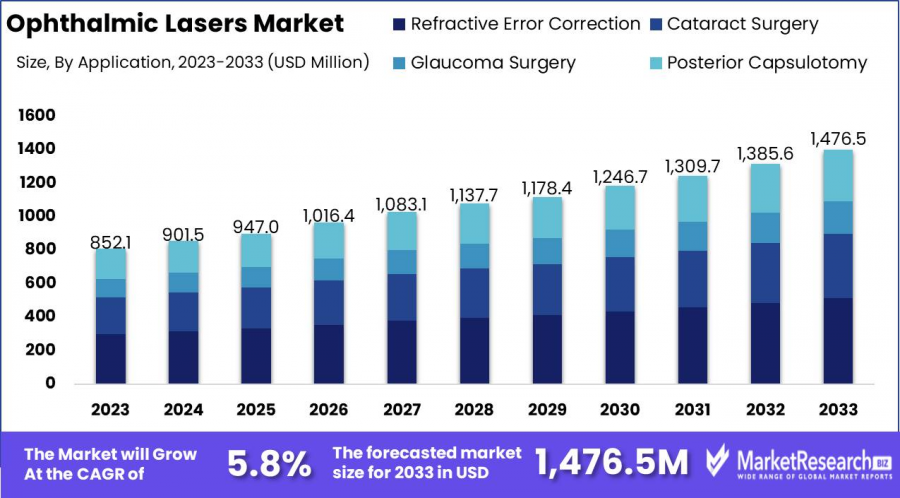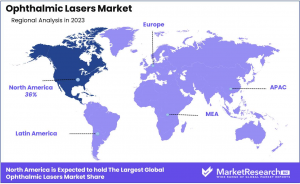
Ophthalmic Lasers Market Poised for Steady Growth, Projected To Hit USD 1.47 Billion by 2033
Global Ophthalmic Lasers Market was valued at USD 852.1 Mn in 2023. It is expected to reach USD 1476.5 Mn by 2033, with a CAGR of 5.8%
NEW YORK, NY, UNITED STATES, February 9, 2025 /EINPresswire.com/ -- Overview
New York, NY – February 10, 2025 – The Global Ophthalmic Lasers Market was valued at USD 852.1 Mn in 2023. It is expected to reach USD 1476.5 Mn by 2033, with a CAGR of 5.8% during the forecast period from 2024 to 2033.
The ophthalmic lasers market is experiencing steady growth, driven by the increasing prevalence of ocular disorders such as cataracts, glaucoma, and diabetic retinopathy. The market is fueled by technological advancements, rising demand for minimally invasive treatments, and an aging population susceptible to eye diseases.
Key laser technologies include femtosecond, excimer, diode, and Nd:YAG lasers, widely used for procedures like LASIK, photocoagulation, and trabeculoplasty. The growing adoption of femtosecond lasers in refractive surgeries has significantly impacted market expansion.
North America dominates the market due to advanced healthcare infrastructure and increasing cases of vision impairment. Meanwhile, Asia-Pacific is witnessing rapid growth, driven by rising awareness, increasing healthcare expenditure, and a growing elderly population.
Major players such as Alcon, Carl Zeiss Meditec, NIDEK, and Lumenis are investing in R&D to introduce next-generation ophthalmic laser systems with enhanced precision and safety. With increasing regulatory approvals and new product launches, the ophthalmic lasers market is poised for significant expansion. The demand for efficient, patient-friendly laser treatments is expected to accelerate growth in the coming years.
Unlock Competitive Advantages With Our PDF Sample Report @ https://marketresearch.biz/report/ophthalmic-lasers-market/request-sample/
Key Takeaways
- Market Growth: The global ophthalmic lasers market was valued at USD 852.1 million in 2023 and is projected to reach USD 1,476.5 million by 2033, growing at a CAGR of 5.8% from 2024 to 2033.
- By Type: Photocoagulation lasers hold a 30% market share, primarily used for retinal disorder treatment and vision correction.
- By Application: Refractive error correction is the dominant segment, accounting for 35%, driven by the rising prevalence of vision impairments.
- By End User: Hospitals are the leading end-users, representing 50% of the market, as they play a key role in providing specialized ophthalmic treatments.
- Regional Dominance: North America holds a 36% market share, supported by technological advancements and high healthcare spending.
- Growth Opportunity: The development of compact, cost-effective laser systems can expand access to advanced ophthalmic care in underserved regions.
Segmentation Analysis
Type Analysis
In 2023, Photocoagulation Lasers dominated the By Type segment of the Ophthalmic Lasers Market, capturing over 30% share. Their widespread use in treating retinal disorders, such as diabetic retinopathy and retinal vein occlusion, drives this dominance. These lasers prevent vision loss by sealing leaking blood vessels and reducing retinal swelling, making them essential in ophthalmology. Their effectiveness and broad application contribute to their market leadership.
Nd:YAG Lasers are vital for posterior capsulotomy and peripheral iridotomy, treating secondary cataracts and glaucoma. These lasers provide high precision and efficacy but hold a smaller market share than photocoagulation lasers due to their specialized applications. Despite their importance, their market penetration remains limited compared to more widely used laser types.
Excimer Lasers play a crucial role in refractive surgeries like LASIK and PRK, reshaping the cornea to correct vision issues. Their high precision and ability to deliver long-term vision correction contribute to their demand. These lasers are widely used in the ophthalmic market, particularly for patients seeking alternatives to glasses or contact lenses.
Femtosecond Lasers are utilized in both refractive and cataract surgeries, offering high precision in tissue cutting and shaping. Their growing adoption is driven by their ability to enhance surgical outcomes. However, their high cost and the need for specialized training limit their market share compared to other ophthalmic laser technologies.
Diode Lasers are valued for their compact size and versatility, with applications in glaucoma and retinal treatments. While they provide efficient treatment options, their market share remains smaller due to their specific use cases and lower demand compared to photocoagulation lasers. Their role in ophthalmology remains important but niche.
Application Analysis
In 2023, Refractive Error Correction dominated the By Application segment of the Ophthalmic Lasers Market, securing over 35% market share. The demand for LASIK and PRK procedures using excimer and femtosecond lasers fuels this dominance. The rising prevalence of myopia, hyperopia, and astigmatism, along with increasing laser-based vision correction, supports market growth. Many patients prefer laser surgeries over glasses or contact lenses, driving adoption.
Cataract Surgery is another significant segment, benefiting from advanced laser technologies that improve surgical precision. The growing aging population and rising cataract cases increase demand for ophthalmic lasers in cataract procedures. These lasers enhance safety and efficiency, making them a preferred choice among eye surgeons.
Glaucoma Surgery focuses on managing intraocular pressure to prevent vision loss in glaucoma patients. Despite its clinical importance, its market share remains smaller than refractive error correction due to the chronic nature of the disease, requiring ongoing management rather than a one-time surgical solution.
Posterior Capsulotomy is a key procedure for treating secondary cataracts, restoring vision clarity after cataract surgery. While it remains essential, its market share is lower than refractive error correction due to its specific postoperative nature. The need for this laser treatment increases with long-term cataract surgery follow-ups.
End User Analysis
In 2023, Hospitals led the By End User segment of the Ophthalmic Lasers Market, holding over 50% market share. Their dominance is due to their advanced equipment, access to skilled ophthalmologists, and ability to handle high patient volumes. Hospitals perform complex and routine laser-based eye treatments, ensuring comprehensive patient care and driving market growth.
Ambulatory Service Centers (ASCs) are growing in importance, offering cost-effective and efficient laser procedures, including LASIK and cataract surgery. Their convenience, shorter wait times, and affordability make them a preferred choice for many patients seeking outpatient eye surgeries.
Clinics play a critical role in routine eye care and minor laser treatments. They offer personalized patient care, making them ideal for non-invasive ophthalmic procedures. While their market share is smaller, clinics provide accessible and specialized eye care, maintaining a steady patient base.
Market Segmentation
By Type
•Photocoagulation Lasers
•Nd:YAG Lasers
•Excimer Lasers
•Femtosecond Lasers
•Diode Lasers
By Application
•Refractive Error Correction
•Cataract Surgery
•Glaucoma Surgery
•Posterior Capsulotomy
By End User
•Hospitals
•Ambulatory Service Centers
•Clinics
Buy This Premium Research Report: https://marketresearch.biz/purchase-report/?report_id=49156
Market Dynamics
Driver: The increasing prevalence of eye disorders, such as cataracts, glaucoma, and diabetic retinopathy, significantly propels the ophthalmic lasers market. According to the World Health Organization, cataracts remain a leading cause of blindness globally, underscoring the need for advanced surgical interventions. Ophthalmic lasers offer precise, minimally invasive treatment options, enhancing patient outcomes and reducing recovery times. The growing aging population further contributes to the demand for these laser procedures, as age-related eye conditions become more common. Consequently, healthcare systems worldwide are increasingly adopting laser-based treatments to address the rising burden of ocular diseases.
Trend: A notable trend in the ophthalmic lasers market is the integration of femtosecond laser technology into cataract surgeries. Femtosecond lasers provide exceptional precision in corneal incisions and lens fragmentation, improving surgical outcomes. This technology aligns with the broader movement towards minimally invasive procedures in ophthalmology. Additionally, the adoption of laser-assisted in situ keratomileusis (LASIK) for refractive error correction reflects a growing preference for laser-based vision correction over traditional methods. These advancements highlight the industry's commitment to leveraging cutting-edge technology to enhance patient care.
Restraint: Despite the benefits, the high cost of ophthalmic laser equipment poses a significant barrier to market growth. Many healthcare facilities, particularly in low- and middle-income countries, struggle to afford these advanced technologies. The World Health Organization emphasizes the importance of accessible eye care services, yet the financial constraints limit widespread adoption. Additionally, the need for specialized training to operate laser systems can impede their utilization, as not all practitioners have access to such education. These factors collectively hinder the global expansion of ophthalmic laser applications.
Opportunity: The increasing focus on early detection and treatment of eye diseases presents a significant opportunity for the ophthalmic lasers market. Public health initiatives aimed at reducing the prevalence of preventable blindness encourage the adoption of advanced diagnostic and therapeutic tools. Ophthalmic lasers, with their precision and efficacy, are well-positioned to play a crucial role in these efforts. Furthermore, ongoing research and development in laser technology promise to introduce more cost-effective and user-friendly devices, potentially expanding their accessibility and application in diverse healthcare settings.
Emerging Trends in Ophthalmic Lasers
•Wavefront Technology: This advanced method creates a detailed 3D map of the eye, allowing for personalized treatments. It helps correct common vision issues like nearsightedness, farsightedness, and astigmatism, as well as more complex problems affecting night vision and contrast sensitivity.
•Femtosecond Lasers: These lasers emit ultra-short light pulses to make precise cuts in the eye's cornea. They are used in surgeries for cataracts, glaucoma, and vision correction, enhancing accuracy and reducing the risk of complications.
•Customized LASIK Procedures: New LASIK techniques focus on improving accuracy, shortening recovery times, and offering more treatment options to meet individual patient needs.
Use Cases of Ophthalmic Lasers
•Cataract Surgery: Lasers assist in removing cloudy lenses from the eye, a condition known as cataracts. This method improves precision and outcomes in cataract surgeries.
•Glaucoma Treatment: For open-angle glaucoma, laser trabeculoplasty is used to enhance fluid drainage from the eye, helping to lower internal eye pressure.
•Retinal Repairs: Lasers are employed to treat retinal issues such as tears or detachment. By creating small burns around a retinal tear, lasers help seal the retina to the underlying tissue, preventing further damage.
•Diabetic Retinopathy: In cases of diabetic retinopathy, laser therapy can reduce the risk of significant vision loss by 50%. However, about 12% of treated patients may still experience vision decline.
Refer More Healthcare Reports-
Humanized Mouse and Rat Model Market - https://marketresearch.biz/report/humanized-mouse-and-rat-model-market/
Microcellular Plastics Market - https://marketresearch.biz/report/microcellular-plastics-market/
Orthostatic Hypotension Drugs Market - https://marketresearch.biz/report/orthostatic-hypotension-drugs-market/
Ophthalmic Viscosurgical Devices (OVD) Research Market - https://marketresearch.biz/report/ophthalmic-viscosurgical-devices-market/
Canada Home Healthcare Market - https://marketresearch.biz/report/canada-home-healthcare-market/
Non-alcoholic Steatohepatitis (NASH) Biomarkers Market - https://marketresearch.biz/report/non-alcoholic-steatohepatitis-nash-biomarkers-market/
IT Spending on Clinical Analytics Market - https://marketresearch.biz/report/it-spending-on-clinical-analytics-market/
Assistive Technologies for Visually Impaired Market - https://marketresearch.biz/report/assistive-technologies-for-visually-impaired-market/
Optometry Market - https://marketresearch.biz/report/optometry-market/
Hyperpigmentation Disorders Treatment Market - https://marketresearch.biz/report/hyperpigmentation-disorders-treatment-market/
Medical Cannabis Market - https://marketresearch.biz/report/medical-cannabis-market/
Lawrence John
Prudour
+91 91308 55334
email us here
Distribution channels: Healthcare & Pharmaceuticals Industry
Legal Disclaimer:
EIN Presswire provides this news content "as is" without warranty of any kind. We do not accept any responsibility or liability for the accuracy, content, images, videos, licenses, completeness, legality, or reliability of the information contained in this article. If you have any complaints or copyright issues related to this article, kindly contact the author above.
Submit your press release


